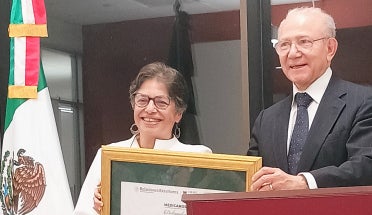
Blanton Museum Presents First U.S. Retrospective of Colombian Artist Oscar Muñoz
- Feb 21, 2022
- by Ellen Stader
A groundbreaking exhibition opened recently at the Blanton Museum of Art, featuring approximately 40 striking artworks rarely seen outside of Colombia. Oscar Muñoz: Invisibilia is the first retrospective in the United States to present works by the renowned artist Oscar Muñoz.
The collected pieces represent five decades of the artist's creative exploration into themes of memory, time, history and knowledge, often interworked with images and elements of his home country.
Co-organized by the Blanton Museum of Art and Phoenix Art Museum, the exhibition will be on view to the public Feb. 20-June 5, 2022. It contains works ranging from the artist’s early charcoal drawings of the late 1970s to videos produced between 2019 and 2021, as well as hybrid pieces in which Muñoz combines photographic processes with drawing, printmaking, installation, video, sculpture and interactive elements.
One such experiential piece greets visitors in the atrium of the museum. Ambulatorio (Walking Place/ Outpatient Ward), 1994-2008, uses an aerial map of Santiago de Cali, the city where Muñoz has worked for decades. The enlarged map is divided into floor sections, which are misaligned to disrupt the map’s original context. Each section is pressed under a layer of tempered security glass such as that used in government offices; the glass is cracked, making it crunch underfoot with every step. This affords the visitor a facsimile experience of walking streets littered with broken glass—a common experience in a city that has seen protests, armed clashes and bombings.
Curated by Vanessa Davidson, Blanton curator of Latin American art and former Shawn and Joe Lampe Curator of Latin American Art at Phoenix Art Museum, Invisibilia represents the first collaboration between the two museums. Davidson has worked closely with Muñoz since 2018 to create this retrospective that traces the evolution of the artist’s radical practice over a storied 50-year career.
“It is an honor to present the first retrospective of Oscar Muñoz’s work in the United States, which will help bring greater awareness to the remarkable work of a leading contemporary artist whose major U.S. debut is long overdue,” said Blanton Director Simone Wicha. “Oscar Muñoz: Invisibilia also represents the Blanton’s first exhibition dedicated solely to Colombian art, a cornerstone of the museum’s vast collection of 20th-century and contemporary Latin American art.”
Born in Popayán, Colombia, in 1951, Oscar Muñoz studied art at the Escuela de Bellas Artes in Cali during the 1970s. Originally trained as a draftsman, he became internationally renowned for riveting works that splice the media of film, video, photography, painting, drawing and installation. His work investigates themes of identity, social amnesia, memory and the impermanence of life, expressed by the use of ephemeral materials like light, water, fire and dust. The result is a body of portraits and experiential works that correlate transient, precarious images with the fragility of life.

Working in a country beset by the catastrophes of civil war, Muñoz’s pieces often illuminate both the playful and dreadful components of life in Colombia. In Pixeles [Pixels] (1999-2000), the country’s two main export crops appear as sugar cubes soaked with differing concentrations of coffee. The cubes are arranged under plexiglass in a mosaic grid of bitter and sweet to create pixelated portraits of people who died in the crossfire between Colombia’s military forces and insurgent rebels. The faces only become recognizable as faces at a distance from the viewer.
Water and carbon, the malleable building blocks of human life, make frequent appearances across the exhibition. In the video titled Re/trato [Portrait/I Try Again] (2004), Muñoz repeatedly sketches himself in water on concrete, the initial strokes of each portrait drying and disappearing before the final strokes are drawn. In the Narciso series, self-portraits are drawn in graphite on water, morphing and transforming, sometimes even disappearing as the water slowly drains or evaporates; the results are filmed or rendered on paper as studies in image, memory, loss and change.

“The universality of Oscar Muñoz’s work lies in his exploration of far-reaching themes of identity, time, knowledge and history in diverse media,” said Davidson. “As viewers experience the exhibition, I hope they consider the ways in which Muñoz uses the simplest means, such as water painted on sun-warmed cement, to illustrate the transience of the image as a metaphor for the transience of life. His artworks are often fleeting—yet they become indelible in our imaginations.”
Muñoz strives to “hacer memoria”—make memory—in his works by turning photographic processes inside out. Said the artist: “I am interested in the instant and the processes that occur so that an image can become consolidated, or not, in memory.”
“I hope visitors contemplate how the meanings of the photographs they take and keep to document their own lives change over time, and how they help to build memory and community,” added Davidson. “What do our selfies say about us, and how do they themselves ‘make memory’?”
Despite his denial of the “photographer” label, Muñoz was awarded the 2018 Hasselblad Foundation International Award in Photography. His work has appeared in numerous international solo and group exhibitions in Mexico, France, Peru, Argentina, Colombia, Switzerland, the United Kingdom and the United States.
In 2006, Muñoz founded Lugar a Dudas (Room for Doubt), a cultural center and residency program for artists in Cali. Sixteen years later, Lugar a Dudas has become a center for international artists to work through ideas and participate in dialogue and public debate about art and politics with the larger community.
“Muñoz is one of the most significant contemporary artists—not only in his native country, but in Latin America at large,” noted Carter E. Foster, Blanton deputy director for curatorial affairs. “This important survey of his works testifies to Vanessa Davidson’s extensive research into Muñoz’s practice and commitment to expanding conversations around contemporary Latin American art. Four years in the making, Oscar Muñoz: Invisibilia has proven to be worth the wait.”
Founded in 1963, the Blanton Museum of Art holds the largest public collection in Central Texas, with more than 21,000 objects. The Blanton offers thought-provoking, visually arresting and personally moving encounters with art.;
Learn more about Oscar Muñoz: Invisibilia on the Blanton Museum of Art website.



